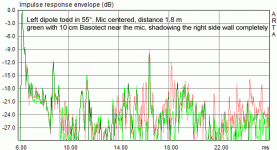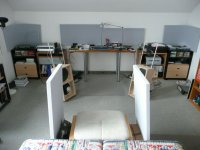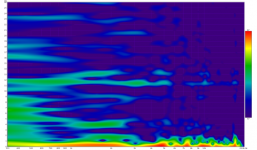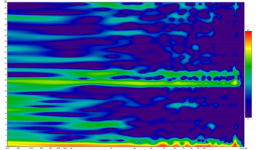Fair enough ...- it's just a bit frustrating for me watching this discussion, which assumes that stereo is inherently so limited. From my perspective I see a bunch of people doing this,
, when there is a very clear solution, a straightforward way of moving forward and achieving more satisfactory sound
Sorry ...
Did you document your "method" somewhere so we all can benefit?
Markus,
For posted ETC, can you show spectrum of 12ms region of results compared to direct sound using short (3ms) window?
Not sure what you're looking for? The ETC shows a couple of very early reflections, probably caused by the absorber.
First of all, "spaciousness" is a descriptive expression, when people use it, they are just expressing a personal impression, which differ quite significantly.
I cannot speaker for other people, but it is my experience, with the same driver, if I treat it so that the CSD is greatly improved, then the spaciousness and details both improve concurrently. If I move the speakers to a more dead room, then the spaciousness improves, and if there is a problem, it becomes more evident. My expression of spaciousness is that the reflective ques seem more separated from the performer, and the room seems larger than it really is if the room is relatively small (less than 20 cubic meters).
I listen to a great variety of music as well, some recordings of which were done at the same time I was listening in the hall, and I know exactly where the mics were.
We're obviously talking about very different perceptions. "Spaciousness" as used in my last few posts means a focused auditory event that occupies a space. It's the same definition used for ASW in psychoacoustic literature.
If I remove reflections (which includes box diffraction effects) then the sound stage shrinks down to the size of a puppet theater, confined to the area between the speakers. There's also no sense of real depth.
The "method" has been stated in posts many times, over several years. Simply put, the system in its entirety should be viewed as a single entity which has the job of reproducing sound correctly, and if it doesn't, then there at least one glitch problem area, weakness stopping that happening. Most likely, there will be numerous issues to be sorted out. And those issues will vary per system, there is no universal set of problems, or solutions; if your car is not running properly it's no good asking your neighbour how he solved his vehicle problems, unless he uses an all-knowing, fixit "guru" ...Did you document your "method" somewhere so we all can benefit?
In my case, amplifiers had poorly engineered power supplies, all electronic components were too susceptible to outside interference, from the mains and RF activity. There were static and grounding misbehaviours, and far too many electrical connections relied on poor quality metal to metal contacts. All these weaknesses compound, and result in typical "hifi" sound.
Once each and every one of these issues were properly addressed I got spacious sound. In other words, it is a process of troubleshooting, eliminating deficiences; rather than engineering workarounds, like room treatments.
I still accept that different designers have different goals, so do customers.Right on the money. Once you 'know' what the system should do, then sheer persistence will reward you with good results. I shake my head at times at how terrible expensive systems sound - it's like a Ferrari with half the spark plugs missing, two flat tyres and the hand brake full on all the time ...
There is a famous story circulating here:
A guy wanted a good audio system and asked a dealer to select everything and give him a quote, the dealer came back with a price for a system that was reasonably high; the when the guy heard the price, his response was "how can I invite friends to listen together with a system like that?", he ended up with a system 10 times the original price.
Taking about cars, I have had some interesting experience with matching intake/ exhaust, electrical systems, spark plugs, tires, oil, etc. If you do the right thing on stock cars, you increase performance and reduce gas consumption as well. But that's a different story. I have actually driven a car to the point where only half of the cylinders were being ignited.
Markus, that's funny. After my own barrier experiment I toed in the speakers a little bit more, because I liked it. Now that I measured how much - they are at 55°I was doing some experiments with increased speaker toe-in. At 56° I get a pretty spacious presentation.
I measured the left speaker again (from some more distance than last time) and then blocked everything coming from the right wall by placing 10 cm Basotect right next to the microphone:

The effect is basicly the same as in your experiment. I had tried to find the single contralateral reflection point on the wall itself and to put the Basotect up there, but to no avail. There was no single point to do it all.
After that I build a two-sided barrier to remove all contralateral reflections when listening:

It is like you experienced already:
I put depth in "()" because I feel a little bit different about the depth impression than you. For the rest this barrier works equivalent to the ambio barrier for me: More precision and detail in the acoustic scene but everything moved away from me - both in spatial distance and in emotional affiliation.Now the image is more detailed and localization is improved but all spaciousness (and depth) is gone.
That's not the way I enjoy music best.
Hi Rudolf,
So you're basically getting the same perception I do. I suspect that intensity-based 2-speaker stereo without crosstalk cancellation is incapable of delivering real spaciousness and depth. All it can do is deliver very sharply focused sounds confined between the speakers. I would need to confirm that by listening outside.
It seems that the sensation of spaciousness in 2-speaker stereo is solely a binaural effect that can be created by the recording and/or the room.
By the way, Rudolf, I put the Basotect directly next to the speaker. This kills reflections more efficiently.
So you're basically getting the same perception I do. I suspect that intensity-based 2-speaker stereo without crosstalk cancellation is incapable of delivering real spaciousness and depth. All it can do is deliver very sharply focused sounds confined between the speakers. I would need to confirm that by listening outside.
It seems that the sensation of spaciousness in 2-speaker stereo is solely a binaural effect that can be created by the recording and/or the room.
By the way, Rudolf, I put the Basotect directly next to the speaker. This kills reflections more efficiently.
The "method" has been stated in posts many times, over several years. Simply put, the system in its entirety should be viewed as a single entity which has the job of reproducing sound correctly, and if it doesn't, then there at least one glitch problem area, weakness stopping that happening. Most likely, there will be numerous issues to be sorted out. And those issues will vary per system, there is no universal set of problems, or solutions; if your car is not running properly it's no good asking your neighbour how he solved his vehicle problems, unless he uses an all-knowing, fixit "guru" ...
In my case, amplifiers had poorly engineered power supplies, all electronic components were too susceptible to outside interference, from the mains and RF activity. There were static and grounding misbehaviours, and far too many electrical connections relied on poor quality metal to metal contacts. All these weaknesses compound, and result in typical "hifi" sound.
Once each and every one of these issues were properly addressed I got spacious sound. In other words, it is a process of troubleshooting, eliminating deficiences; rather than engineering workarounds, like room treatments.
That's too general to be of any value, sorry.
Yes, this can happen, and I did come across issues like this. However, when I cleaned up the CSD of drivers, and the details came out, then the auditory event started coming back. Solving the electronics and interface issues bring them back as well. The only thing I can say is, the more one tries to use combination of many acoustic waves, there is no way the fidelity is going to improve with design changes. Rather, you go through cycles of changes which change the sound, and then you end up where you were before. The effects of changes are not accumulative, just like a chef cooking food where the more you put in, you may like the taste, but it becomes more difficult to experience the natural taste of what you eat. Which is also why people cannot determine whether they are eating horse meat or beef.We're obviously talking about very different perceptions. "Spaciousness" as used in my last few posts means a focused auditory event that occupies a space. It's the same definition used for ASW in psychoacoustic literature.
If I remove reflections (which includes box diffraction effects) then the sound stage shrinks down to the size of a puppet theater, confined to the area between the speakers. There's also no sense of real depth.
I agree, actually. Unless the audio enthusiast has the right perspective and approach then it's probably not going to happen for them; because the people selling and designing the gear don't "get it", and there is no general body of information one can tap into easily.That's too general to be of any value, sorry.
One can use the analogy of a space capsule with an air leak: no matter how expensive the materials used, and how air tight 99.99% of the capsule is, if there's one leak somewhere then all the "perfection" elsewhere is close to useless, the device is not fit for the purpose of keeping astronauts alive. So the answer is to find where that leak is: does someone write a manual describing how one should investigate everything to find that leak ...?
Have heard that ... it's all about social standing, the audio industry is badly twisted by such perspectives. The half dozen peopleA guy wanted a good audio system and asked a dealer to select everything and give him a quote, the dealer came back with a price for a system that was reasonably high; the when the guy heard the price, his response was "how can I invite friends to listen together with a system like that?", he ended up with a system 10 times the original price.
You were trying to kill it, perhaps ...Taking about cars, I have had some interesting experience with matching intake/ exhaust, electrical systems, spark plugs, tires, oil, etc. If you do the right thing on stock cars, you increase performance and reduce gas consumption as well. But that's a different story. I have actually driven a car to the point where only half of the cylinders were being ignited.
That is an unfortunate belief. Stereo IS quite capable of doing this.I believe that stereo itself isn't capable of delivering any spaciousness that is perceived as real or natural.
Yes it can. And it can do it superbly well. It isn't easy to achieve, but I've heard it done so well that it was mind blowing. It's something you just don't expect and it will mess with your mind.In two-speaker stereo all reflections that could carry information about spaciousness are lumped together in two locations, namely the left and right speaker location. This can't create a sense natural spaciousness.
Agreed. I suppose I would not have believed it either, if I hadn't heard it.Trouble is, until one hears what can be achieved, then this is probably a reasonable conclusion.
Markus, it's too bad we couldn't have gotten you on a train and over to Paris when I was doing the big system demos at Espace Kiron - they were quite magnificent. Those demos would have changed your mind, and spoiled you for life.
Then again, who knows? Maybe the effect would not work for you. Maybe you are similar to my neighbor in the 1970s who simply could not hear a difference between stereo and mono. Some people are different.
That is an unfortunate belief. Stereo IS quite capable of doing this.
Yes it can. And it can do it superbly well. It isn't easy to achieve, but I've heard it done so well that it was mind blowing. It's something you just don't expect and it will mess with your mind.
So HOW is it achieved? Please, please, pretty please. You claimed multiple times it could be achieved but never described how it is achieved.
And how can you be so sure it's not a room effect? Or a binaural effect?
Markus,
For posted ETC, can you show spectrum of 12ms region of results compared to direct sound using short (3ms) window?
For what it's worth, left speaker at listening position, with absorption of contralateral reflection:
With no absorption:
Settings are the same as in your graph.
Attachments
If I remove reflections (which includes box diffraction effects) then the sound stage shrinks down to the size of a puppet theater, confined to the area between the speakers. There's also no sense of real depth.
this is unfortunately also my experience, and am puzzled my Pano's comments. High directivity, again?
I would have come to Paris! :-(
Last edited:
I believe that stereo itself isn't capable of delivering any spaciousness that is perceived as real or natural.
Since it seems to be popular to quote Griesinger, here's one more. I found from one of his presentations many years ago from his home page (I don't know if it is still available), it was mentioned that stereo triangle has one narrow freq range where spaciousness can be perceived. He gave an example of recorded applouse from an audience in a hall. It sounded plausible and I immediately listened some of classical recordings having applouse in between the music. And yes, the applouse sounds very spacious from 2 speaker stereo triangle !
But that's all stereo triangle itself can do, and here the phenomena is totally signal dependent.
I imagine other noise like sounds having similar freq range as applouse can sound spacious with stereo triangle, too.
- Elias
Probably a binaural effect? The head works as a barrier to some extend, so stereo might indeed be capable of wave field reconstruction for a very specific type of signal. But this is not how stereo is used in control and mastering rooms. The effect isn't described anywhere.
So HOW is it achieved? Please, please, pretty please. You claimed multiple times it could be achieved but never described how it is achieved.
And how can you be so sure it's not a room effect? Or a binaural effect?
I would like the answer to this as well, as I completely agree with you assertions on stereo.
Get in speaker's near field and there's lots of spaciousness cues to be heard, and lots of engagement, as Griesinger would say.
So the necessary spacial info is in the recording.
Move out of that near field and the effect disappears.
So the loss of engagement is likely a room effect.
Time to read carefully what Griesinger has to say about engaging sound and what kills it.
Or, figure out how to extend speakers near field into room/mask room's effect
So the necessary spacial info is in the recording.
Move out of that near field and the effect disappears.
So the loss of engagement is likely a room effect.
Time to read carefully what Griesinger has to say about engaging sound and what kills it.
Or, figure out how to extend speakers near field into room/mask room's effect
Last edited:
- Home
- Loudspeakers
- Multi-Way
- Linkwitz Orions beaten by Behringer.... what!!?

